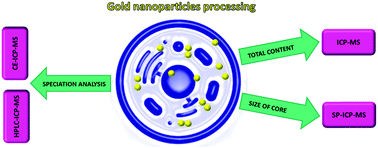Joint forces of direct, single particle, CE– and HPLC–inductively coupled plasma mass spectrometry techniques for the examination of gold nanoparticle accumulation, distribution and changes inside human cells†
Abstract
The intracellular localization and transformation of gold nanoparticles (AuNPs) are among the crucial aspects in future applications in cancer therapy. In the context of the study, inductively coupled plasma mass spectrometry (ICP-MS)-based techniques were effectively applied to reveal the fate of AuNPs internalized in cancerous MCF-7 cells. Direct ICP-MS was used to obtain quantitative information about the distribution rate of gold from the AuNPs in the cells, namely their membranes, cytosol as well as nuclei. Moreover, the combination of capillary electrophoresis and reversed-phase liquid chromatography with ICP-MS was used as a tool to probe and compare for the effective monitoring of the speciation changes of the gold-containing forms in the cytosol. The chemical nature (ionic vs. nano) of the metal detected in the cytosol was verified via ICP-MS in a single-particle mode, confirming the stability of the nanomaterials and the absence of ionic gold forms inside the cells.



 Please wait while we load your content...
Please wait while we load your content...